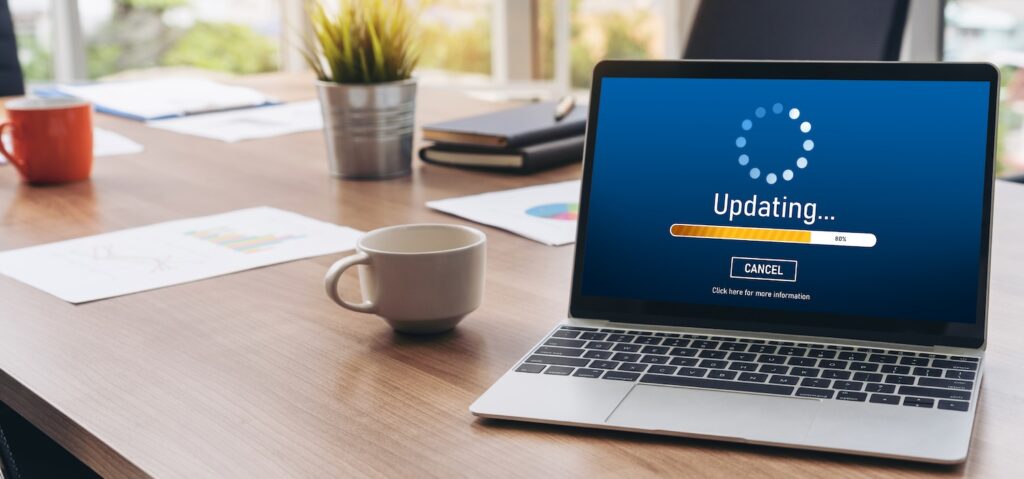Building a Seamless Web Presence: Avoiding Common CMS Pitfalls
Many of us have experienced the gut-wrenching moment of visiting a favorite website, only to be greeted with a dreaded error message or an outdated design. While frustrating for users and CMS website owners, these website woes can be costly for businesses, impacting brand reputation and hindering online success.
Content Management Systems (CMS) have revolutionized website creation and management, empowering individuals and businesses to build engaging online presences without the need for extensive coding knowledge. However, navigating the vast landscape of CMS options and ensuring their effective use can pose its own set of challenges.
This comprehensive guide serves as your roadmap to navigating this landscape. We’ll delve into the common pitfalls that businesses and individuals often encounter when utilizing a CMS, equipping you with the knowledge and strategies to sidestep these obstacles and build a thriving online presence.
Don’t Let Your Website Become a Hacked Hostage: Security Woes and Solutions
In today’s digital world, websites are more than just online brochures; they are often the cornerstone of a business’s online presence. However, a compromised website can have devastating consequences, leading to data loss, reputational damage, and even financial losses.

The unfortunate reality is that Content Management Systems (CMS) are not immune to security threats. In 2019, a major data breach at a popular CMS platform exposed the personal information of millions of users, highlighting the importance of robust security measures.
Building a Secure Foundation:
The good news is that by implementing best practices, you can significantly reduce the risk of your website becoming a victim of a cyberattack. Here are some key strategies to consider:

- Regular Updates: Outdated CMS software and plugins often contain security vulnerabilities that attackers can exploit. Make it a priority to keep your CMS, plugins, and themes updated with the latest security patches.
- Strong Passwords & User Access Control: Implement strong password policies that require users to create complex passwords and change them regularly. Additionally, enforce the principle of least privilege, granting users only the minimum level of access necessary to perform their tasks.
- Secure Hosting: Choose a reputable web hosting provider that prioritizes security. Look for features like firewalls, intrusion detection systems, and regular backups. Backups are crucial for recovering your website in the event of a successful attack.

- Security Scanning & Monitoring: Regularly scan your website for vulnerabilities using automated tools. Additionally, monitor your website activity for signs of suspicious behavior, such as unusual login attempts or changes to website files.
Dealing with a Security Breach:
While taking preventive measures is crucial, even the most secure website can be targeted. If you suspect your website has been compromised, it’s important to act quickly and decisively:
- Notify the Authorities: Report the breach to the relevant authorities, such as law enforcement and any regulatory bodies you may be subject to.
- Restore Backups: If you have a recent backup of your website, use it to restore your website to a clean state.
- Investigate the Breach: Work with a security expert to investigate the nature of the breach and identify any vulnerabilities that need to be addressed.
By following these security best practices and being prepared to respond to potential threats, you can significantly reduce the risk of your website becoming a victim of a cyberattack and safeguard your online presence. Remember, website security is an ongoing process, not a one-time fix. By staying vigilant and proactive, you can ensure that your website remains a secure and trusted platform for your visitors.
Avoiding E-commerce CMS Disasters
For e-commerce businesses, a website is more than just a digital storefront; it’s the primary battleground for attracting customers and securing sales. However, technical glitches and common CMS pitfalls can quickly turn this battlefield into a minefield, leading to frustrated customers, abandoned carts, and lost revenue.
The Cost of a Glitchy Checkout:
Imagine a customer browsing your online store, adding their dream product to their cart, only to encounter an error message at checkout. This scenario, unfortunately, is a reality for many e-commerce businesses due to common CMS issues like slow loading times, payment gateway integration problems, or even website crashes during peak traffic hours.
These technical glitches can have a significant negative impact on your bottom line. Studies have shown that website abandonment rates can soar as high as 90% due to slow loading times alone. Additionally, a single instance of a website crash during a sale or promotional event can translate to lost sales and a tarnished brand reputation.
Choosing the Right Weapon for the Fight:
Selecting the right CMS platform is the first step towards creating a successful online store. When choosing a CMS specifically for your e-commerce needs, consider these key factors:
- Scalability: As your business grows, your website traffic and product offerings will inevitably increase. Choose a CMS that can scale efficiently to accommodate your future needs.
- Security: E-commerce websites handle sensitive customer data, making robust security features paramount. Ensure your chosen CMS prioritizes security with features like secure payment gateways and regular security updates.
- Payment Gateway Integrations: Seamless integration with popular payment gateways is crucial for a smooth checkout experience. Look for a CMS that offers built-in support for commonly used payment gateways.
- Built-in E-commerce Features: Many CMS platforms offer built-in features specifically designed for e-commerce, such as product management tools, shopping cart functionality, and customer account management. Evaluate the available features and choose a CMS that aligns with your specific needs.
Optimizing for Victory:
Once you’ve chosen the right CMS platform, it’s crucial to optimize your website for performance and user experience. Here are some key strategies:
- Choose the Right Hosting Plan: Select a web hosting plan that can handle the expected traffic volume and has the necessary resources to ensure smooth website operation.
- Optimize Images: Large image files can significantly slow down your website’s loading times. Use image compression tools and optimize image sizes for web display.
- Caching: Implement caching mechanisms to store frequently accessed website elements, reducing server load and improving website loading times.
By carefully selecting your e-commerce CMS, optimizing for performance, and planning for future growth, you can transform your website from a potential minefield into a smooth-running sales machine, driving customer satisfaction and boosting your online revenue.
From Frustrated Editor to Content Hero: Avoiding Common Usability Pitfalls
Imagine an editor struggling to navigate a clunky CMS interface, spending hours formatting text instead of crafting engaging content. This scenario, unfortunately, is a reality for many businesses struggling with usability issues within their CMS platforms.
The User Journey Matters:

A user-friendly CMS experience is crucial for content editors and administrators. An intuitive interface with clear navigation and easy-to-use content creation tools empowers editors to focus on what matters most: creating high-quality content that resonates with your audience. Conversely, a cumbersome CMS can lead to frustration, inefficiency, and ultimately, a decline in content quality.
Content Workflow Woes:
Disorganized content management can quickly lead to chaos. Version control issues can result in outdated content being published, broken links can frustrate website visitors, and inconsistent branding can damage your professional image.
Streamlining for Success:
Fortunately, by implementing best practices, you can transform your CMS from a source of frustration into a tool for content creation efficiency. Here are some key strategies:
- Establish Editorial Calendars: Planning content creation in advance with an editorial calendar helps maintain consistency, avoid last-minute scrambles, and ensure a steady flow of fresh content.
- Utilize Content Management Tools: Many CMS platforms offer built-in features and extensions to streamline content creation, such as drag-and-drop editing tools, image libraries, and scheduling functionalities. Explore and utilize these features to maximize efficiency.
- Set Clear Communication Guidelines: Establish clear communication guidelines regarding content creation, editing, and approval processes. This ensures everyone is on the same page, reduces confusion, and facilitates collaboration.
Empowering Your Editors:
Investing in your editors through training and resources is critical. Providing training sessions on the CMS functionalities, best practices for content creation, and style guidelines empowers your editors to become content heroes, capable of creating engaging and impactful content that drives audience engagement and achieves your content marketing goals.
By prioritizing user-friendliness, streamlining workflows, and empowering your editors, you can transform your CMS platform from a potential pitfall into a springboard for content creation success.
Choosing the Right CMS for Your Needs
In the ever-evolving world of web development, selecting the right Content Management System (CMS) is crucial for building and managing your website. However, navigating the landscape of CMS options, particularly the distinction between traditional and headless systems, can be overwhelming.
Understanding the Battleground:
Traditional CMS: Imagine a one-stop shop for website creation and management. Traditional CMS platforms like WordPress or Wix offer a user-friendly interface, built-in design templates, and content management tools, making them ideal for beginners or those with limited technical expertise. However, their “all-in-one” approach can limit flexibility and scalability for complex websites or those requiring frequent updates to functionality.
Headless CMS: Think of a content management system that acts like the brain of your website, focusing solely on content creation, editing, and storage. Headless CMS platforms like Contentful or Prismic decouple the content backend from the front-end presentation layer. This separation allows for greater flexibility and customization, enabling delivery of content across various platforms and devices, from websites and mobile apps to smartwatches and digital displays. However, headless CMS typically require more technical expertise for setup and integration, making them less suitable for users without coding knowledge.
Choosing Your Champion:
The optimal CMS choice hinges on a number of factors:
- Technical Expertise: If your team lacks coding experience, a user-friendly traditional CMS might be preferable. However, if you have developers on board, a headless CMS can offer greater customization potential.
- Budget: Traditional CMS platforms often come with lower upfront costs, while headless CMS might involve additional development and integration expenses.
- Project Needs: Consider the specific features and functionalities your website requires. If you need a simple blog or brochure website, a traditional CMS might suffice. However, for complex websites requiring frequent updates or multi-platform delivery, a headless CMS could be a better fit.
- Desired Level of Flexibility: If you envision frequent changes to your website’s look and feel or need to deliver content across multiple platforms, a headless CMS offers superior flexibility. Traditional CMS may be sufficient if your website structure and design are expected to remain relatively static.
Ultimately, the “right” CMS is the one that best aligns with your specific needs and resources. By understanding the strengths and limitations of both traditional and headless CMS options, you can make an informed decision and empower your website to thrive in the ever-evolving digital landscape.
Your CMS: From Pitfall to Powerhouse
Throughout this comprehensive guide, we’ve delved into the complexities of Content Management Systems (CMS), exploring the common pitfalls that can hinder your online success. Armed with this knowledge, you’re now equipped to navigate the vast CMS landscape with confidence, making informed decisions that empower your website to thrive. Remember, a well-managed CMS is not just a tool; it’s a strategic partner in your digital journey. By actively implementing the best practices outlined here, you can:
Fortify your online presence: Proactive security measures like regular updates, strong passwords, and secure hosting safeguard your website from cyber threats, protecting your data and reputation.
Optimize for seamless user experiences: A user-friendly CMS empowers both editors and visitors. Editors can efficiently create and manage content thanks to intuitive interfaces and streamlined workflows, while visitors enjoy a smooth and engaging browsing experience.
Drive e-commerce success: Choose the right e-commerce CMS and optimize for fast loading times and seamless checkouts, minimizing cart abandonment and maximizing sales.
Embrace adaptability: Whether you require the user-friendliness of a traditional CMS or the flexibility of a headless solution, understanding your project needs and technical expertise allows you to select the ideal CMS for your unique requirements.
By staying informed, adopting a proactive approach, and continuously seeking improvement opportunities, you can transform your CMS from a potential pitfall into a springboard for digital success. Embrace the power of your CMS and embark on a journey of creating a website that not only functions flawlessly but also reflects your brand identity and resonates with your audience










Thanks for sharing. I read many of your blog posts, cool, your blog is very good.
Thank you